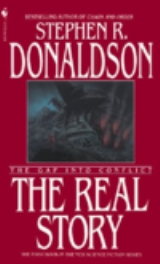
The Gap Cycle
Encyclopedia
The Gap Cycle is a science fiction
story, told in a series of 5 books, written by Stephen R. Donaldson
. It is an epic set in a future where humans have pushed far out into space in the name of commerce and follows two concurrent story arcs. The first concerns an ensign in the United Mining Companies Police (UMCP), Morn Hyland, who is attempting simply to stay alive after being captured by a marauder named Angus Thermopyle. The second follows the Byzantine political maneuvering of the head of the UMCP, Warden Dios, as he attempts to thwart the machinations of his boss, the CEO of United Mining Companies (UMC) itself, Holt Fasner.
Note: the recent Gollancz (UK) reprints of the series combine the first two books into a single volume. According to Donaldson's website, this was done at the author's request.
As explained in the author's afterword in The Real Story
, this series started life as a novella
in which characters representing villain, victim, and rescuer would switch places during the course of the narrative. He found the result unsatisfying, and the book was shelved until he had the idea of setting a retelling of Wagner's Ring Cycle
in the same universe, and casting the characters from The Real Story in roles from Wagner's opera.
The Real Story novella became Volume 1, and the rest of the series explores the Wagner theme. The series is not the Ring Cycle explicitly retold, but more an interpretation set in a future universe.
Like the author's other major work, The Chronicles of Thomas Covenant, the Unbeliever
, the story is characterised by a dark and bleak atmosphere. It is intended for adult readers.
Angus boards the wreck hoping to salvage some air scrubbers, murders Morn's father (who had survived Morn's attempted self-destruction) and kidnaps Morn. Seeking both control of her gap-sickness, and Morn herself, Angus places a zone implant — a remotely-controlled electrode — into her brain, which allows Angus to control Morn's every feeling and action. By giving Morn an unauthorised zone implant, Angus has committed a capital crime, and will be executed if he is caught.
On the way back to Com-Mine, Angus activates Morn's zone implant, allowing him to repeatedly rape and abuse her. Unwittingly, he also starts to form an emotional attachment to her.
Back at the station, Morn makes contact with another pirate — Nick Succorso, captain and owner of the ship Captain's Fancy, who she sees as a potential rescuer. She aids Nick in framing Angus for stealing station supplies, and Angus is arrested. Before he is taken away, though, Angus gives Morn the remote control to her zone implant, in exchange for her silence. With the control in her possession, Morn is effectively a superwoman and is able to disregard fear, pain, or fatigue; but by accepting the control she is also complicit in Angus' crime against her.
Morn leaves with Nick in his ship. Nick, however, turns out to be every bit as nasty as Angus. When Morn turns out to be pregnant (with Angus' child, although she tells Nick it is his), Nick takes Morn to Enablement Station, a space station in alien-influenced space. The aliens are known as the Amnion and are masters of genetic manipulation. Where humans control space through physical, military and political means, the Amnion gain control by genetic methods — mutating non-Amnion life-forms into Amnioni. Only the technological and military might of the UMCP keeps them at bay.
At Enablement Station, the Amnion use their advanced biological technology to
speed up Morn's pregnancy, allowing her to give birth much earlier than
normal. Her child, named Davies after her now-dead father, is force-grown into
an adult and imprinted with Morn's mind. During the imprinting procedure, Morn
uses her zone implant to retain her sanity. This surprises the Amnion, as normally the process of mind-imprinting destroys the original mind — Morn has used some process to preserve her sanity, but the Amnion don't know what this process is. If they can discover and replicate this process, the Amnion can create human-resembling Amnion and potentially gain control over human-inhabited space. As such, Davies becomes very valuable to the Amnion. When Morn breaks Davies out of the Amnion's captivity and flees aboard Captain's Fancy, the Amnion commit an act of interstellar war and pursue them into human space.
Meanwhile, the UMCP has "requisitioned" Angus from his prison on Com-Mine Station, and transformed him into a cyborg under their direct control, to be used as a tool against other pirates. Secretly though, Angus has orders to rescue Morn from Nick and return her to Earth.
Warden Dios, Director of the UMCP, turns out to be playing a very deep game. His boss, Holt Fasner — known as "The Dragon", is CEO of the United Mining Companies and owner of the UMCP, and is the most powerful human being in existence. Fasner is utterly corrupt, and Dios wants to end the corruption — corruption in which he has been entirely complicit. Dios is using Morn and Angus to create an artificial crisis through which he can expose the Dragon's corruption and remove the UMCP from the UMC's control — destroying himself in the process. If Dios is to be successful, Morn is required to arrive on Earth to testify that she helped Nick (who is an occasional agent-of-convenience of the UMCP) to frame Angus with the assistance of Com-Mine Station Security — an act which led to the passage of the Preempt Act and made the Dragon the de facto ruler of humanity.
Similarly, Holt Fasner's name can be seen to be a conflation of Fasolt and Fafner, the names of the two giants who build Wotan's stronghold/headquarters, Valhalla. Also, "The Dragon," Warden's nickname for his boss, more than hints at Fafner's transforming into a dragon after killing Fasolt, his brother-partner and the last of his kind to challenge him in his lust for power. Appropriately, Warden cannot be seen plotting against Holt because he is his primary trusted employee; and in "The Ring," Fasolt and Fafner are protected from any direct action Wotan can take against them because of the contract they made with him in agreeing to build Valhalla. In addition, Holt Fasner's comparison to Fafner is further demonstrated by both characters' ultimate desire for immortality; Fasner by means of possessing the technology of the Amnion and Fafner by his possession of Freia's golden apples, the source of the gods' immortality.
Also, Holt's apparently prescient mother, Norna, is likely named after both Erda, the all-seeing, all-wise goddess of the Earth and her daughters, the Norse Fates, or Norns. Wotan's desire to seek counsel from the reclusive Erda on how to escape Alberich's curse is reflected here when Warden visits Norna in her seclusion in hopes to find a way to defeat "The Dragon."
Min Donner implies the parallel of two Wagnerian roles. The obvious comparison is of the Thunder God, "Donner" who wields his mighty hammer in defense of the Gods, as does the UMCP's Enforcement Director, Min Donner, defending Earth and Space against the hostile forces of the galaxy. Donaldson goes out of his way to note on several occasions that Min's impact pistol never leaves her side, creating a parallel with the Ring's Donner and his hammer. Yet, her character and dramatic use in the books suggests that she, more so, represents Brünnhilde, Wotan's favorite Valkyrie daughter/subordinate. Notably, in "The Ring," Brünnhilde, like the Gap Cycle's Min, also tries to carry out Wotan's/Warden's deepest desires, even though he has not explicitly instructed her to. Warden also has a secret love and respect for Min, not only as the master/father does for the apprentice/child but, much like Wotan's Brünnhilde, for whom she has developed on her own.
Likewise, Godsen Frik (another reference to the Gods), the Director Of Protocol's name, hints that his character parallels Fricka, Wotan's wife and Goddess of Marriage and Virtue. But, Godsen's role within the Gap Cycle shows that his purpose more closely aligns with that of Wagner's Freia: the price that Wotan/Warden must pay Holt/Fasolt and Fafner for building Valhalla/giving the UMCP almost total power. Further, the fact that Donner, Wagner's very male Thunder God, becomes Min Donner, the very forceful female head of UMCP's Enforcement Division, is nicely reversed when Donaldson changes Fricka and Freia, two rather passive goddesses, into the rather effeminate Godsen Frik the male Director of UMCP's Protocol Division.
With the character of the eccentrically clever scientist, Hashi Lebwohl, who represents Loge, the cunning, trickster god of fire in the Ring Cycle, Donaldson's naming schema is less obvious. Quoting the author himself: "Some things I can explain. Others happen purely by intuition or "feel," and them I can't explain. So: "Leb wohl" ("farewell") is what Wotan sings to Brünnhilde as he puts her into an enchanted sleep (as punishment for defending Sigmund and Sieglinde against him) right before he summons Loge to guard her with fire. (All of this, of course, is from Wagner's "Ring" cycle.) Thus Loge's fire becomes the symbol of Wotan's love and respect for Brünnhilde, and of his bereavement at losing her — and at everything that follows from her defiance. So it isn't much of a stretch to see the fire (and therefore Loge) as Wotan's farewell gift to Brünnhilde, the magic which eventually enables her to bring about his destruction. But "Hashi" I can't explain. It just popped into my head—and felt right. However, it may conceivably be a reference to "hashish," and therefore to Hashi's rather dissociated (or perhaps I should say oblique) relationship with people and events. (On the other hand, I may just be grasping at straws.")
(Quote taken from here.)
Milos Taverner, the scheming coward who slyly uses his enemies against one another for his own personal gain and survival, could easily recall Wagner's "Mime". While Milos is caught between his assignment by Warden, his fear/control of Angus' powers, and his treacherous alliance with the Amnion, Mime's self-made trap between Wotan's prophecy, his fear/using of Siegfried's strengths and his lust for revenge on Alberich is comparable. Both cowards cannot sustain their game of falsehood which, in turn, leads to their ultimate doom at the hands of their targets. The threat and ambitions of the Amnion reflect Alberich's plan to enslave all life in the name of ultimate power, by which the futility of such plans are evidently purposeless upon achieving their goal.
Regarding the names of the three main characters of the story, Donaldson explains (in his Author's Note at the end of The Real Story) that he came up with the names "Angus Thermopyle", "Morn Hyland" and "Nick Succorso" while driving, and used them in his series because he liked the sound of them. While these names bear no likeness to the names of any of the "Ring Cycle" characters, the author is clear that his "Angus" and "Morn" function much as "Siegmund" and "Sieglinde".
While there are many dissimilarities, the fact that both Wotan and Warden strategically place their children/unwitting agents in harm's way in order to save humankind from total destruction is the key element which sets both dramas in motion. Angus and Morn/Siegmund and Sieglinde consummate their relationship illegally (rape/incest) and produce invaluable offspring (Davies/Siegfried) who hold the key to freeing humanity from their dependency on the UMC/Gods.
Nick Succorso's stretch of a comparison to Hagen can be made by his obsessive need for revenge directed at/serving the one who scarred/created him. But he is more observably compared to Hunding. Sieglinde is allowed to be taken by Hunding and forced into an abusive relationship/marriage with him. It is Siegmund (like Angus) who rescues her by means of Wotan's secret plan. Likewise, Warden has also allowed Nick to possess and abuse Morn only to be rescued by Angus' covert UMCP-programmed mission. Further, when Fricka demands that Wotan abandon Siegmund and Sieglinde and give executional victory to Hunding, we are closely reminded of Warden's confrontation with Holt in which "The Dragon" orders Warden to abandon Angus and Morn and turn over command to Nick, with orders to kill them.
This leads us to a hidden parallel in the naming of the UMCP's gap scout vessel, "Trumpet". Wagner's use of the leitmotif in his music dramas (a musical passage used to identify principal characters, significant objects and emotions) and his brilliant orchestrations often feature certain musical instruments in the playing of a given theme. The sword that Wotan promises to Siegmund (which is instrumental in leading him to the rescue of the shamed Sieglinde) is first identified in "The Ring", musically, by trumpets. The sword is named by Siegmund as "Needful", while "Trumpet" is a Needle Class vessel and is the essential instrument/weapon/protection given to Angus as he sets off to covertly rescue Morn. Here, Donaldson, while lacking the vehicle of music in novel form, creates his own leitmotif, if you will, thereby hinting not only at Wagner, but his compositional techniques as well.
Lastly, the most obvious parallel is the title of Donaldson's final book in his cycle, "This Day All Gods Die." Wagner's final installment of his cycle is called, "Götterdämmerung" or "Twilight Of The Gods." Both refer to the demise of the ruling power of the UMC/Gods brought about by the willing sacrifice of both Warden Dios and Wotan. Donaldson's acknowledgment of the apparent inspirational symbols of Wagner's "Ring" in his own work is, in itself, comparable to the composer's own admitted inspiration by the Norse and Volsung mythological sagas.
Examples:
Science fiction
Science fiction is a genre of fiction dealing with imaginary but more or less plausible content such as future settings, futuristic science and technology, space travel, aliens, and paranormal abilities...
story, told in a series of 5 books, written by Stephen R. Donaldson
Stephen R. Donaldson
Stephen Reeder Donaldson is an American fantasy, science fiction and mystery novelist, most famous for his Thomas Covenant series...
. It is an epic set in a future where humans have pushed far out into space in the name of commerce and follows two concurrent story arcs. The first concerns an ensign in the United Mining Companies Police (UMCP), Morn Hyland, who is attempting simply to stay alive after being captured by a marauder named Angus Thermopyle. The second follows the Byzantine political maneuvering of the head of the UMCP, Warden Dios, as he attempts to thwart the machinations of his boss, the CEO of United Mining Companies (UMC) itself, Holt Fasner.
Books in series
| The Gap Series | ||||
|---|---|---|---|---|
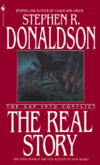 Book 1 |
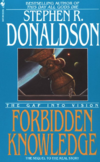 Book 2 |
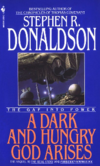 Book 3 |
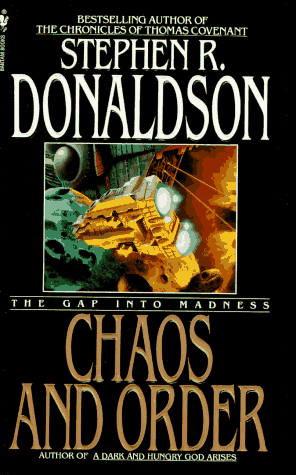 Book 4 |
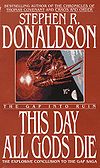 Book 5 |
- The Gap into Conflict: The Real StoryThe Real StoryThe Real Story is the first book of The Gap Cycle by Stephen R. Donaldson, a science fiction series.-Plot summary:...
, Bantam/Spectra, 19901990 in literatureThe year 1990 in literature involved some significant events and new books.-Events:*J. K. Rowling gets the idea for Harry Potter while on a train ride from Manchester to London. She says "I was staring out the window, and the idea for Harry just came. He appeared in my mind's eye, very fully formed... - The Gap into Vision: Forbidden KnowledgeForbidden KnowledgeForbidden Knowledge is the second book of The Gap Cycle by Stephen R. Donaldson, a science fiction series.-Plot introduction:...
, Bantam/Spectra, 19911991 in literatureThe year 1991 in literature involved some significant events and new books.-Events:*Douglas Coupland publishes the novel Generation X: Tales for an Accelerated Culture, popularizing the term Generation X as the name of the generation.... - The Gap into Power: A Dark and Hungry God ArisesA Dark and Hungry God ArisesA Dark and Hungry God Arises is the third book of The Gap Cycle by Stephen R...
, Bantam/Spectra, 19921992 in literatureThe year 1992 in literature involved some significant events and new books.-New books:*Ben Aaronovitch - Transit*Julia Álvarez - How the García Girls Lost Their Accents*Paul Auster - Leviathan*Iain Banks - The Crow Road... - The Gap into Madness: Chaos and OrderChaos and OrderChaos and Order is the fourth book of The Gap Cycle by Stephen R. Donaldson, a science fiction series.-Plot introduction:...
, Bantam/Spectra, 19941994 in literatureThe year 1994 in literature involved some significant events and new books.-New books:*Kevin J. Anderson - Champions of the Force, Dark Apprentice and Jedi Search*Reed Arvin - The Wind in the Wheat*Greg Bear - Songs of Earth and Power... - The Gap into Ruin: This Day All Gods DieThis Day All Gods DieThis Day All Gods Die, officially The Gap into Ruin: This Day All Gods Die, is a science fiction novel by Stephen R. Donaldson, being the final book of The Gap Cycle.It...
, Bantam/Spectra, 19961996 in literatureThe year 1996 in literature involved some significant events and new books.-Events:*Harper Lee's novel, To Kill a Mockingbird, is removed from an advanced placement English reading list in Lindale, Texas because it "conflicted with the values of the community."* In the United Kingdom, the first...
Note: the recent Gollancz (UK) reprints of the series combine the first two books into a single volume. According to Donaldson's website, this was done at the author's request.
As explained in the author's afterword in The Real Story
The Real Story
The Real Story is the first book of The Gap Cycle by Stephen R. Donaldson, a science fiction series.-Plot summary:...
, this series started life as a novella
Novella
A novella is a written, fictional, prose narrative usually longer than a novelette but shorter than a novel. The Science Fiction and Fantasy Writers of America Nebula Awards for science fiction define the novella as having a word count between 17,500 and 40,000...
in which characters representing villain, victim, and rescuer would switch places during the course of the narrative. He found the result unsatisfying, and the book was shelved until he had the idea of setting a retelling of Wagner's Ring Cycle
Der Ring des Nibelungen
Der Ring des Nibelungen is a cycle of four epic operas by the German composer Richard Wagner . The works are based loosely on characters from the Norse sagas and the Nibelungenlied...
in the same universe, and casting the characters from The Real Story in roles from Wagner's opera.
The Real Story novella became Volume 1, and the rest of the series explores the Wagner theme. The series is not the Ring Cycle explicitly retold, but more an interpretation set in a future universe.
Like the author's other major work, The Chronicles of Thomas Covenant, the Unbeliever
The Chronicles of Thomas Covenant, the Unbeliever
The Chronicles of Thomas Covenant, the Unbeliever is a trilogy of fantasy novels by Stephen R. Donaldson. It was followed by The Second Chronicles of Thomas Covenant, also a trilogy, and The Last Chronicles of Thomas Covenant, a planned tetralogy....
, the story is characterised by a dark and bleak atmosphere. It is intended for adult readers.
Plot summary
Morn Hyland, an ensign with the United Mining Companies Police, is on her first mission aboard the UMCP destroyer Starmaster (which is crewed by members of her extended family). When they arrive at Com-Mine Station, a ship, Bright Beauty, piloted by the pirate Angus Thermopyle, flees, and Starmaster follows. Witnessing Angus slaughtering a small mining settlement (Angus had left Com-Mine without supplies and needs air scrubbers), Starmaster attempts combat, but is almost destroyed by a massive internal explosion. Morn suffers from gap-sickness, a mental disorder that inflicts itself on a small portion of people who travel through the Gap (the series' analogue to hyperspace). Symptoms of gap-sickness vary wildly; in Morn, it manifests itself as an uncontrollable urge to engage in self-destruction and is triggered by exposure to high-gravity conditions. Morn, left alone on the auxiliary bridge when Starmaster engaged Angus' ship, experienced gap-sickness for the first time, and attempted to destroy Starmaster.Angus boards the wreck hoping to salvage some air scrubbers, murders Morn's father (who had survived Morn's attempted self-destruction) and kidnaps Morn. Seeking both control of her gap-sickness, and Morn herself, Angus places a zone implant — a remotely-controlled electrode — into her brain, which allows Angus to control Morn's every feeling and action. By giving Morn an unauthorised zone implant, Angus has committed a capital crime, and will be executed if he is caught.
On the way back to Com-Mine, Angus activates Morn's zone implant, allowing him to repeatedly rape and abuse her. Unwittingly, he also starts to form an emotional attachment to her.
Back at the station, Morn makes contact with another pirate — Nick Succorso, captain and owner of the ship Captain's Fancy, who she sees as a potential rescuer. She aids Nick in framing Angus for stealing station supplies, and Angus is arrested. Before he is taken away, though, Angus gives Morn the remote control to her zone implant, in exchange for her silence. With the control in her possession, Morn is effectively a superwoman and is able to disregard fear, pain, or fatigue; but by accepting the control she is also complicit in Angus' crime against her.
Morn leaves with Nick in his ship. Nick, however, turns out to be every bit as nasty as Angus. When Morn turns out to be pregnant (with Angus' child, although she tells Nick it is his), Nick takes Morn to Enablement Station, a space station in alien-influenced space. The aliens are known as the Amnion and are masters of genetic manipulation. Where humans control space through physical, military and political means, the Amnion gain control by genetic methods — mutating non-Amnion life-forms into Amnioni. Only the technological and military might of the UMCP keeps them at bay.
At Enablement Station, the Amnion use their advanced biological technology to
speed up Morn's pregnancy, allowing her to give birth much earlier than
normal. Her child, named Davies after her now-dead father, is force-grown into
an adult and imprinted with Morn's mind. During the imprinting procedure, Morn
uses her zone implant to retain her sanity. This surprises the Amnion, as normally the process of mind-imprinting destroys the original mind — Morn has used some process to preserve her sanity, but the Amnion don't know what this process is. If they can discover and replicate this process, the Amnion can create human-resembling Amnion and potentially gain control over human-inhabited space. As such, Davies becomes very valuable to the Amnion. When Morn breaks Davies out of the Amnion's captivity and flees aboard Captain's Fancy, the Amnion commit an act of interstellar war and pursue them into human space.
Meanwhile, the UMCP has "requisitioned" Angus from his prison on Com-Mine Station, and transformed him into a cyborg under their direct control, to be used as a tool against other pirates. Secretly though, Angus has orders to rescue Morn from Nick and return her to Earth.
Warden Dios, Director of the UMCP, turns out to be playing a very deep game. His boss, Holt Fasner — known as "The Dragon", is CEO of the United Mining Companies and owner of the UMCP, and is the most powerful human being in existence. Fasner is utterly corrupt, and Dios wants to end the corruption — corruption in which he has been entirely complicit. Dios is using Morn and Angus to create an artificial crisis through which he can expose the Dragon's corruption and remove the UMCP from the UMC's control — destroying himself in the process. If Dios is to be successful, Morn is required to arrive on Earth to testify that she helped Nick (who is an occasional agent-of-convenience of the UMCP) to frame Angus with the assistance of Com-Mine Station Security — an act which led to the passage of the Preempt Act and made the Dragon the de facto ruler of humanity.
Characters
The events of The Gap Cycle can be separated into twin plot arcs – those taking place out on the edges of human-occupied space; and those set on or above Earth. The characters can likewise be distributed.Illegals
- Captain Angus Thermopyle
- Captain Nick Succorso
- Mikka Vasaczk
- Ciro "Pup" Vasaczk
- Dr. Vector Shaheed
- Sib Mackern
- Captain Sorus Chatelaine
The Gap Cycle versus Wagner's Ring Cycle: a comparison
At a first glance, the most obvious similarity between these two works, apart from the story, are the names of the various characters. If The Gods in Wagner's "Ring" are represented in Donaldson's cycle as the Directors of the United Mining Companies Police, Warden Dios approximates Wotan, ruler of the Wagnerian gods. The prosthetic eye that Warden wears is a dead give-away, but his surname, Dios, is also the Spanish word for God. In addition,"Warden" is seen as a variation of "Woden," the chief Norse god whose name gave rise to Wagner's "Wotan."Similarly, Holt Fasner's name can be seen to be a conflation of Fasolt and Fafner, the names of the two giants who build Wotan's stronghold/headquarters, Valhalla. Also, "The Dragon," Warden's nickname for his boss, more than hints at Fafner's transforming into a dragon after killing Fasolt, his brother-partner and the last of his kind to challenge him in his lust for power. Appropriately, Warden cannot be seen plotting against Holt because he is his primary trusted employee; and in "The Ring," Fasolt and Fafner are protected from any direct action Wotan can take against them because of the contract they made with him in agreeing to build Valhalla. In addition, Holt Fasner's comparison to Fafner is further demonstrated by both characters' ultimate desire for immortality; Fasner by means of possessing the technology of the Amnion and Fafner by his possession of Freia's golden apples, the source of the gods' immortality.
Also, Holt's apparently prescient mother, Norna, is likely named after both Erda, the all-seeing, all-wise goddess of the Earth and her daughters, the Norse Fates, or Norns. Wotan's desire to seek counsel from the reclusive Erda on how to escape Alberich's curse is reflected here when Warden visits Norna in her seclusion in hopes to find a way to defeat "The Dragon."
Min Donner implies the parallel of two Wagnerian roles. The obvious comparison is of the Thunder God, "Donner" who wields his mighty hammer in defense of the Gods, as does the UMCP's Enforcement Director, Min Donner, defending Earth and Space against the hostile forces of the galaxy. Donaldson goes out of his way to note on several occasions that Min's impact pistol never leaves her side, creating a parallel with the Ring's Donner and his hammer. Yet, her character and dramatic use in the books suggests that she, more so, represents Brünnhilde, Wotan's favorite Valkyrie daughter/subordinate. Notably, in "The Ring," Brünnhilde, like the Gap Cycle's Min, also tries to carry out Wotan's/Warden's deepest desires, even though he has not explicitly instructed her to. Warden also has a secret love and respect for Min, not only as the master/father does for the apprentice/child but, much like Wotan's Brünnhilde, for whom she has developed on her own.
Likewise, Godsen Frik (another reference to the Gods), the Director Of Protocol's name, hints that his character parallels Fricka, Wotan's wife and Goddess of Marriage and Virtue. But, Godsen's role within the Gap Cycle shows that his purpose more closely aligns with that of Wagner's Freia: the price that Wotan/Warden must pay Holt/Fasolt and Fafner for building Valhalla/giving the UMCP almost total power. Further, the fact that Donner, Wagner's very male Thunder God, becomes Min Donner, the very forceful female head of UMCP's Enforcement Division, is nicely reversed when Donaldson changes Fricka and Freia, two rather passive goddesses, into the rather effeminate Godsen Frik the male Director of UMCP's Protocol Division.
With the character of the eccentrically clever scientist, Hashi Lebwohl, who represents Loge, the cunning, trickster god of fire in the Ring Cycle, Donaldson's naming schema is less obvious. Quoting the author himself: "Some things I can explain. Others happen purely by intuition or "feel," and them I can't explain. So: "Leb wohl" ("farewell") is what Wotan sings to Brünnhilde as he puts her into an enchanted sleep (as punishment for defending Sigmund and Sieglinde against him) right before he summons Loge to guard her with fire. (All of this, of course, is from Wagner's "Ring" cycle.) Thus Loge's fire becomes the symbol of Wotan's love and respect for Brünnhilde, and of his bereavement at losing her — and at everything that follows from her defiance. So it isn't much of a stretch to see the fire (and therefore Loge) as Wotan's farewell gift to Brünnhilde, the magic which eventually enables her to bring about his destruction. But "Hashi" I can't explain. It just popped into my head—and felt right. However, it may conceivably be a reference to "hashish," and therefore to Hashi's rather dissociated (or perhaps I should say oblique) relationship with people and events. (On the other hand, I may just be grasping at straws."
(Quote taken from here.)
Milos Taverner, the scheming coward who slyly uses his enemies against one another for his own personal gain and survival, could easily recall Wagner's "Mime". While Milos is caught between his assignment by Warden, his fear/control of Angus' powers, and his treacherous alliance with the Amnion, Mime's self-made trap between Wotan's prophecy, his fear/using of Siegfried's strengths and his lust for revenge on Alberich is comparable. Both cowards cannot sustain their game of falsehood which, in turn, leads to their ultimate doom at the hands of their targets. The threat and ambitions of the Amnion reflect Alberich's plan to enslave all life in the name of ultimate power, by which the futility of such plans are evidently purposeless upon achieving their goal.
Regarding the names of the three main characters of the story, Donaldson explains (in his Author's Note at the end of The Real Story) that he came up with the names "Angus Thermopyle", "Morn Hyland" and "Nick Succorso" while driving, and used them in his series because he liked the sound of them. While these names bear no likeness to the names of any of the "Ring Cycle" characters, the author is clear that his "Angus" and "Morn" function much as "Siegmund" and "Sieglinde".
While there are many dissimilarities, the fact that both Wotan and Warden strategically place their children/unwitting agents in harm's way in order to save humankind from total destruction is the key element which sets both dramas in motion. Angus and Morn/Siegmund and Sieglinde consummate their relationship illegally (rape/incest) and produce invaluable offspring (Davies/Siegfried) who hold the key to freeing humanity from their dependency on the UMC/Gods.
Nick Succorso's stretch of a comparison to Hagen can be made by his obsessive need for revenge directed at/serving the one who scarred/created him. But he is more observably compared to Hunding. Sieglinde is allowed to be taken by Hunding and forced into an abusive relationship/marriage with him. It is Siegmund (like Angus) who rescues her by means of Wotan's secret plan. Likewise, Warden has also allowed Nick to possess and abuse Morn only to be rescued by Angus' covert UMCP-programmed mission. Further, when Fricka demands that Wotan abandon Siegmund and Sieglinde and give executional victory to Hunding, we are closely reminded of Warden's confrontation with Holt in which "The Dragon" orders Warden to abandon Angus and Morn and turn over command to Nick, with orders to kill them.
This leads us to a hidden parallel in the naming of the UMCP's gap scout vessel, "Trumpet". Wagner's use of the leitmotif in his music dramas (a musical passage used to identify principal characters, significant objects and emotions) and his brilliant orchestrations often feature certain musical instruments in the playing of a given theme. The sword that Wotan promises to Siegmund (which is instrumental in leading him to the rescue of the shamed Sieglinde) is first identified in "The Ring", musically, by trumpets. The sword is named by Siegmund as "Needful", while "Trumpet" is a Needle Class vessel and is the essential instrument/weapon/protection given to Angus as he sets off to covertly rescue Morn. Here, Donaldson, while lacking the vehicle of music in novel form, creates his own leitmotif, if you will, thereby hinting not only at Wagner, but his compositional techniques as well.
Lastly, the most obvious parallel is the title of Donaldson's final book in his cycle, "This Day All Gods Die." Wagner's final installment of his cycle is called, "Götterdämmerung" or "Twilight Of The Gods." Both refer to the demise of the ruling power of the UMC/Gods brought about by the willing sacrifice of both Warden Dios and Wotan. Donaldson's acknowledgment of the apparent inspirational symbols of Wagner's "Ring" in his own work is, in itself, comparable to the composer's own admitted inspiration by the Norse and Volsung mythological sagas.
Scientific credibility
Books of The Gap Cycle reference terms commonly used in cosmology, physics and advanced computer technology; however, in some cases the terms used in the books are inconsistent with their currently associated concepts and scientific observation.Examples:
- Gravitational singularities.
- Silicon-on-Diamond (SOD) CMOSCMOSComplementary metal–oxide–semiconductor is a technology for constructing integrated circuits. CMOS technology is used in microprocessors, microcontrollers, static RAM, and other digital logic circuits...
circuitry – a supposed future development of the real silicon on sapphireSilicon on sapphireSilicon on sapphire is a hetero-epitaxial process for integrated circuit manufacturing that consists of a thin layer of silicon grown on a sapphire wafer. SOS is part of the Silicon on Insulator family of CMOS technologies...
(SOS) technology. - DNADNADeoxyribonucleic acid is a nucleic acid that contains the genetic instructions used in the development and functioning of all known living organisms . The DNA segments that carry this genetic information are called genes, but other DNA sequences have structural purposes, or are involved in...
mutation.
External links
- Stephen R. Donaldson's official website
- Stephen Donaldson Home Page at Kent State UniversityKent State UniversityKent State University is a public research university located in Kent, Ohio, United States. The university has eight campuses around the northeast Ohio region with the main campus in Kent being the largest...
- Bibliography on SciFanSciFanSciFan is an online database for fans of science fiction and fantasy books.The site provides detailed bibliographies, linking books together into series' where appropriate and, in turn, grouping series by universe...
- Forbidden Space: A Stephen R. Donaldson fanfiction archive at Wizards.pro
- Kevin's Watch: Stephen R. Donaldson's officially sanctioned discussion forum

